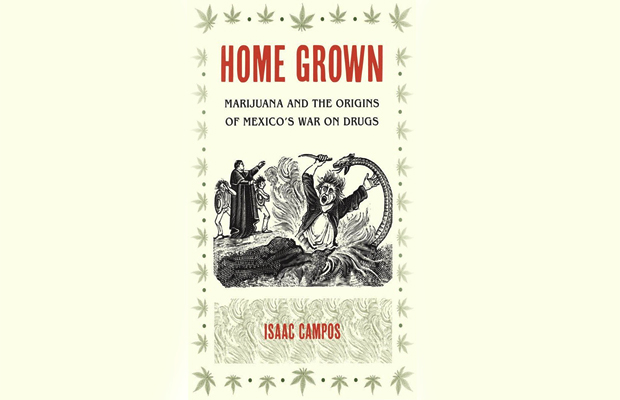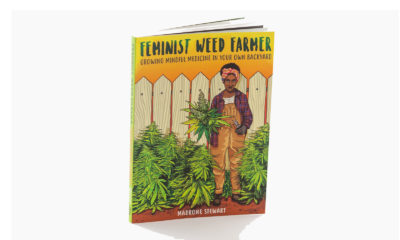Books
Home Grown: Marijuana and the Origins of Mexico’s War on Drugs by Issac Campos
Everyone knows that the U.S. government’s campaign against cannabis has been racially motivated from the beginning: that influxes of Mexican immigrants in the 1910s and 20s spurred border towns like El Paso and states like California to criminalize the drug found to be so popular among the Latinos; that William Randolph Hearst snatched the word “marijuana” from an obscure folk song about pot-smokin’ Pancho Villa and used it to obscure the true nature of the “new drug threat”; and that American news outlets (including Hearst’s) fictionalized sordid “news stories” of degenerate Mexicans gone suddenly violently insane upon the smoking of this “killer herb,” drumming up popular support for pot prohibition in the South and West. Everyone knows that in the subsequent hysteria, popular myths about sexual deviancy and permanent insanity sprang up in the American zeitgeist, creating a culture of fear around perceived existential threats to the cherished American way of life. And everyone knows that the U.S. has forced its prohibitionist, militarist cannabis policy onto its southern neighbor, making a sovereign nation a surrogate for its global war on drugs.
What everyone knows is wrong. In Home Grown: Marijuana and the Origins of Mexico’s War on Drugs, Isaac Campos, professor of history at the University of Cincinnati, explodes these cherished myths and more, overwhelming many a convenient narrative with a barrage of facts. Beginning in the year 1530, when an enterprising Spaniard supposedly became the first European to bring hemp to the New World, Campos paints an exhaustive picture of the development of Mexico’s cannabis policy all the way up to 1920, when the country criminalized it on a national level. In so doing, he convincingly documents the book’s central premise: far from an invention of U.S. drug warriors imposing their political will on their Latin neighbors, the prohibition of cannabis was in fact pioneered in Mexico, decades before American legislatures acted. And when they did act, they copied the Mexican policy nearly verbatim. In short, Mexico’s drug war was home grown.
Through comprehensive reviews of the historical records, Campos reveals the earliest tensions between cannabis culture and its perennial antagonists, religion and pharmaceuticals. Religious opposition came early from the Catholic Church, concerned that some of the indigenous people of Mexico — already in possession of a rich cultural knowledge of psychoactive plants — preferred religious sacraments like psilocybin mushrooms, peyote, and — yes — cannabis to the offered sacraments of bread and weak wine. Thus, none other than the Spanish Inquisition became the first entity to ban drugs in the New World, as far back as 1620.
Opposition from pharmaceutical interests came later, and in a much more nuanced context. As part of a newly independent state, the political elites of 19th century Mexico became obsessed with the idea of elevating their state to the echelons of “civilized” countries — meaning European. This elite fixation became fueled, Campos argues, by a national anxiety around Mexico’s mestizo heritage, compelling many elites to wring their hands over whether their forefathers’ dalliances with indigenous tribes might have polluted their genetics with a primitive, Oriental streak (Asian people were widely considered by contemporary Europeans as representing a less evolved expression of humanity). While corruption became rife in the new country, Mexicans eschewed en masse any activity, including the ritual uses of cannabis adopted by indigenous tribes, which might cause the “degeneracy” of the Mexican people away from the European ideal. Thus, even though “extract of cannabis indica” made its way into the Mexican Farmacopeia, the 19th century elites treated the holistic administrations of cannabis employed by the native herbolarias with disdain, setting up an elaborate pharmacy system around the latest research of “Western” medicine and severely restricting the distribution of cannabis.
Yet even more central to Campos’s thesis is the nexus between cannabis use and insanity, two concepts which have been bandied together in the U.S. for nearly a century. Campos proves that Mexican doctors raised red flags about the supposedly causal relationship between pot smoking and insanity, warning that users could be driven into homicidal maniacs within minutes of their first puffs. More provocatively, Campos further asserts that this popular notion, while seeming absurd in today’s context, might have actually been true in 19th century Mexico — that a widespread, unchallenged belief in the insanity-producing effects of marijuana might have actually so affected the “drug, set, and setting” of the user’s experience as to become a self-fulfilling prophecy. Campos points to an unchallenged unanimity of elite public opinion (culled from a massive, newly digitized trove of Mexico City newspapers) as proof that there had to have been at least some truth behind the hysteria.
At this point, Home Grown’s thesis begins to show signs of strain, as too much of the data becomes lost in caveats, ambiguity, and — in one case — near nonexistence. While Campos ably makes the case that surely someone in Mexico went violently insane at some point after smoking marijuana, the majority of his most credible sources agree that such reactions were rare. Much of the contrary data indicating a possible cannabis-insanity link comes tainted with significant caveats, such as the real possibility of datura or opium becoming confused with cannabis or other maddeningly poor methodologies of 19th century researchers. Weakest of all is the claim that even the illiterate lower classes of Mexico held a universally dim view of the cannabis plant, based on little more evidence than a recurring cartoon character named “Sir Joey Pothead” (Don Chepito Mariguano).
Despite these flaws, Home Grown remains an invaluable resource for any serious student of the history of North American drug policy. Author Isaac Campos has done the world a great service, debunking several cherished myths about the early drug wars and providing a cautionary tale illustrating what happens to the historical arcs of countries which take a strictly punitive stance toward a relatively harmless drug.
First appeared in Issue 4 of Cannabis Now Magazine.
Click here to purchase

















